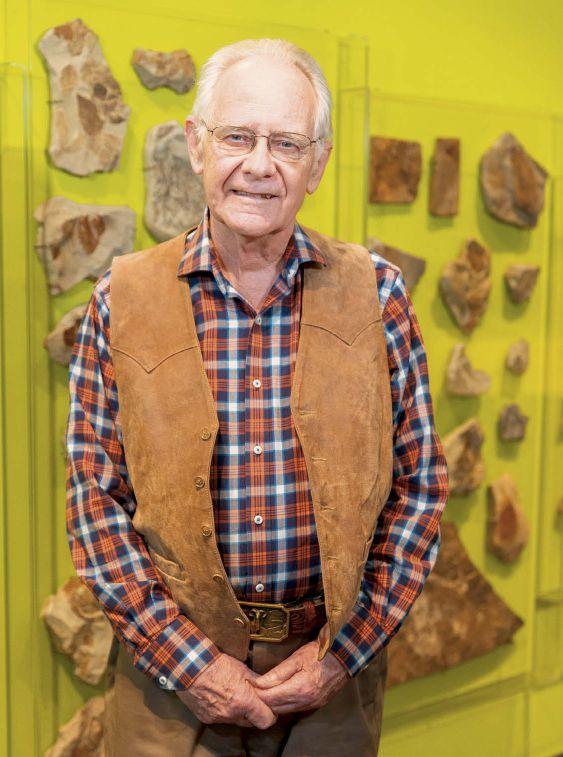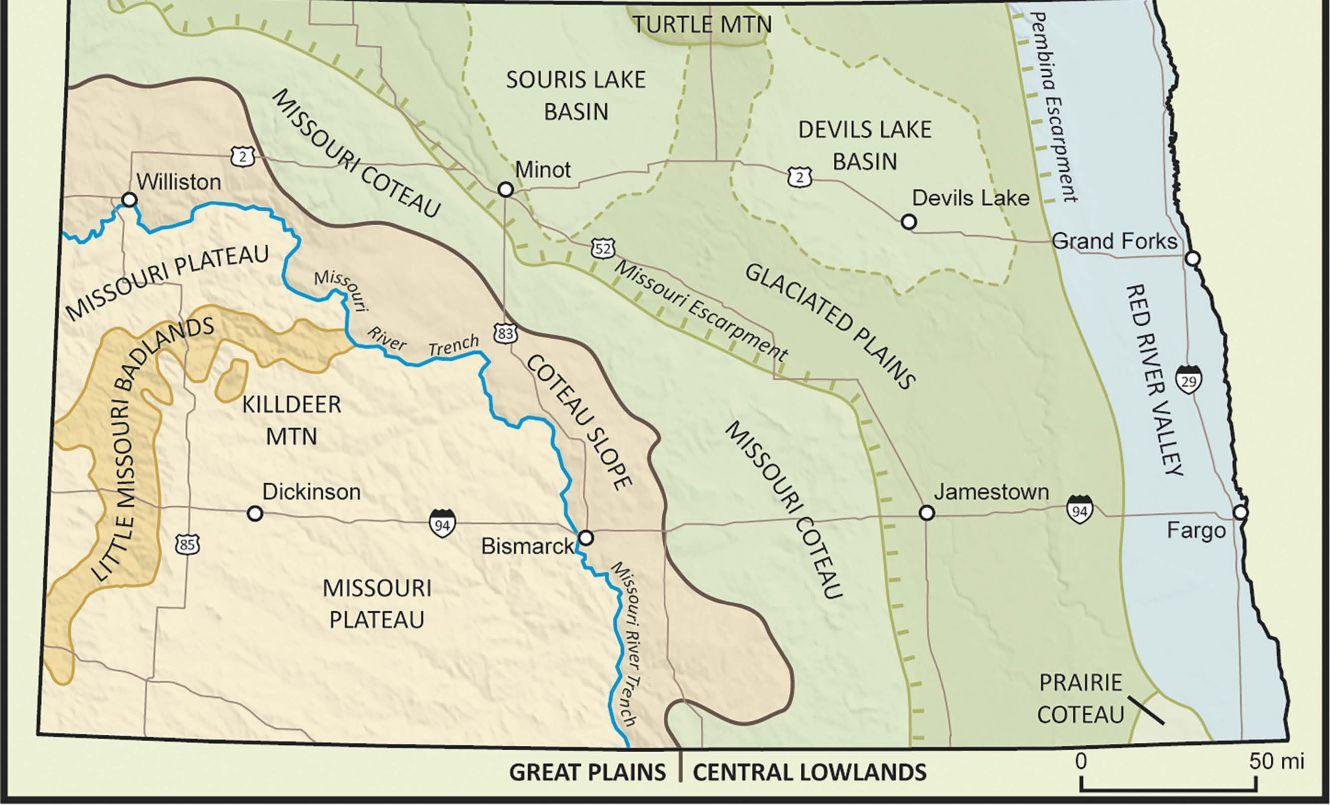
4 minute read
Geology is destiny: A Q&A with John Bluemle
Don’t be fooled by North Dakota’s comparatively flat terrain, says John Bluemle, retired North Dakota state geologist. The state’s geology has a Rocky Mountain-sized impact, especially where energy resources are concerned.
IN YOUR 2016 BOOK, “NORTH DAKOTA’S GEOLOGIC LEGACY,” YOU OFFER A VIVID MODEL OF GEOLOGIC TIME – ONE THAT YOU CREDIT TO DONALD SCHWERT, PROFESSOR EMERITUS OF GEOLOGY AT NORTH DAKOTA STATE UNIVERSITY. COULD YOU SHARE IT WITH PRAIRIE BUSINESS READERS, PLEASE?
A.
The model gives readers an idea of the vastness of time and a sense of the immensity of geologic history. It compares geologic history to something that people understand: the length of Interstate Highway 94, west to east, through North Dakota.
The Earth is 4.6 billion years old. In the I-94 timeline, the 350mile distance across the state, from Beach to Fargo, represents those 4.6 billion years. Bismarck, almost half way through the state, would be a little over two billion years into the age of the Earth. Primitive life such as algae would exist.
The Bakken oil formed 359 million years ago, 91 percent of the way, near the Buffalo-Alice exit on I-94. Dinosaurs showed up near Casselton, 94 percent of the way, and died off in West Fargo.
The earliest humans arrived halfway through Fargo. And North Dakota became a state just a half inch before we reach the boundary between Fargo and Moorhead, Minn.
Q.
Q. A.
REGARDING THE DEVELOPMENT OF NORTH DAKOTA’S ENERGY RESOURCES, WHAT ARE SOME OF THE KEY POINTS ALONG THAT TIMELINE?
Lignite, which outcrops in many places in the western two-thirds of North Dakota, was used by the American Indians for centuries. In 1805, Lewis & Clark gathered it from the banks of the Missouri River. In 1867, tests were conducted at Fort Stevenson, near modern-day Washburn, N.D., to determine the BTUs in lignite.
Before 1900, gas was known on the Cedar Creek Anticline, in southwestern North Dakota and southeastern Montana. In 1912, it was used for heating and streetlights in Baker, Mont. About 1910, in north central North Dakota, shallow gas was discovered and used for domestic purposes in Mohall, N.D., and regional farms.
The Williston Oil Basin was named in 1916, and the first dry-hole oil well was drilled that year. Numerous dry holes were drilled into the 1940s. In 1951, the Clarence Iverson No. 1 well, completed near Tioga, N.D., resulted in the first economic production of oil in North Dakota.
For more than 50 years, successful oil wells produced from many non-shale horizons. It wasn’t until this century that technology developed to the point that the oil-rich Bakken shale was productive.
Q. A.
WHAT IS IT ABOUT NORTH DAKOTA’S GEOLOGY THAT MAKES THE STATE’S ENERGY RESOURCES UNIQUE? IN OTHER WORDS, WHAT HAS NORTH DAKOTA GOT THAT, SAY, GEORGIA AND NEW MEXICO HAVEN’T GOT?
Probably the most important feature about North Dakota’s geology is the deep Williston Oil Basin. Two-thirds of the Williston Basin is in North Dakota, the biggest oil producing basin on the continent. Due to this geologic feature, we have a massive petroleum resource and currently rank second in the United States in oil production. The Basin also provides a large supply of coal and natural gas.
Second, our plains topography leads to unimpeded air flow. We’re America’s “windiest” state, and wind energy provides ever-increasing amounts of power. We even have potential hydrogen production from wind.
North Dakota also has and continues to develop nearly all of the other major energy sources. These include solar, hydropower, biofuels (liquid and gas), and geothermal (ground-source heat).
Q. A.
HOW DOES GEOTHERMAL ENERGY FIT INTO THE PICTURE?
The popularity of geothermal systems in North Dakota has been related more to economics than geology. As the economics (including tax advantages) change and other ways of providing heat become relatively less expensive, the financial benefit of geothermal heat pumps disappears.
Ground source (geothermal) heat pumps are popular in North Dakota because they are most efficient in extreme climates with hot summers and cold winters. Geology is important from a driller’s perspective and also in terms of thermal conductivity, but only because it factors into the design and placement of the geothermal system –especially a large, commercial one, such as at the North Dakota Heritage Center or at Davies High School in Fargo. Geology does not have much influence otherwise.
Q. A.
DESCRIBE THE EXTENT OF NORTH DAKOTA’S LIGNITE RESOURCE.
Lignite underlies much of the western two-thirds of North Dakota and is exposed downward from the land surface to depths reaching 1,800 feet. We mine the uppermost few hundred feet.
North Dakota is one of the country’s top 10 coalproducing states, mining about 30 million tons of lignite coal annually. About 80 percent is used to generate electricity, 13 percent is used to make synthetic natural gas, and 7 percent is used to produce fertilizer products.
Gasification of lignite began near Beulah, N.D., in 1984 in the nation’s only coal-to-synthetic natural gas or “syngas” plant. The plant produces a variety of agricultural fertilizer products. The gasification process captures 8,500 tons of carbon dioxide daily, which is piped to oil fields in Saskatchewan to re-pressurize depleted oil fields.
North Dakota’s lignite industry, with an economic impact exceeding $3 billion a year, provides low-cost power to two million customers in five states. Electricity is generated at six lignite-fueled power plants in western North Dakota and eastern Montana. The average consumer price of the electricity generated is less than half what residents of states on the east and west coasts pay.
Q. A.
HOW ABOUT THE AMOUNT OF OIL THAT’S CURRENTLY BOUND UP IN THE BAKKEN SHALE? WHAT ARE YOUR THOUGHTS WHEN YOU CONTEMPLATE THE SIZE OF THAT RESOURCE?
In 1956, the year I started college, M. King Hubbert, an American geologist and geophysicist, predicted that U.S. oil production would peak in 1976. My college professors taught Hubbert’s “peak oil” theory as gospel, and I remember later arguing with my office partner at the North Dakota Geological Survey about it. He was a retired oil man, and he thought the idea was ridiculous: “When we think we’ve run out of oil, we’ll just go out and find more,” he said.
As he predicted, continuing advances in extraction technology – particularly those that led to the extraction of tight oil and oil from shale – drastically changed the picture.
The Williston Basin Bakken, in northwestern North Dakota, northeastern Montana and southern Saskatchewan, along with other shale oil reserves such as the Marcellus Shale in eastern North America and the Barnett Shale in Texas, dwarf the kind of traditional resources Hubbert was dealing with in the 1950s. One recent estimate of the amount of oil remaining worldwide is about 1,700 billion barrels. That is a lot of oil!










